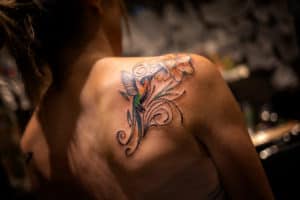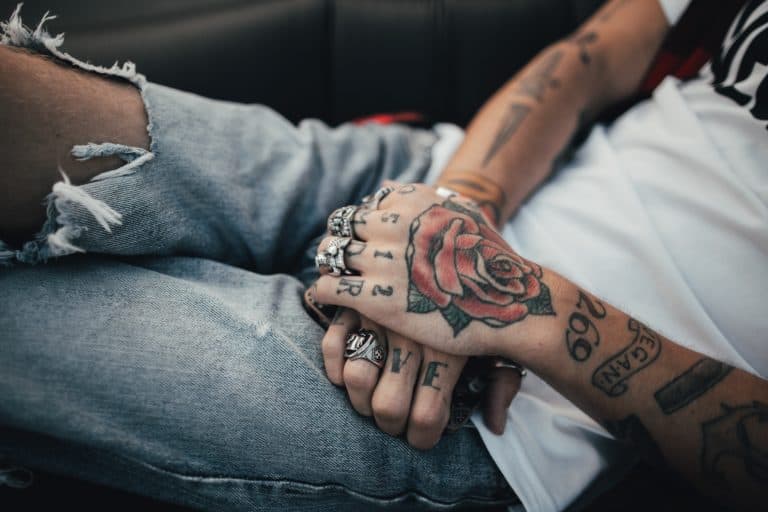Tattoos are beautiful expressions of your life. It can be a reminder of positivity or a tribute to life and love. It reveals a piece of your personality and a glimpse of the person you are.
Getting tattooed requires time and careful consideration. Your choice of design should mean something to you. You also need to have proper expectations of the process and the aftercare.
One of the main concerns, especially of folks who get a tattoo for the first time, is the bruising. For your peace of mind, remember that bruising is normal and one of the typical results of the tattooing process.
Why Do Tattoos Bruise?
Tattoos are made using needles that push the color pigments deep into your skin. These needles repeatedly go through the top layer of your skin and into the layer next to it, causing your skin to be wounded.
Imagine having to endure these hundreds of times per session, especially if you are getting a large design. Your skin and tissues receive such trauma that it ends up bruised. As a result, the area around your newly inked skin may become yellow, bluish, or purple, and sometimes there might be swelling too.
For a normal wound, the objective is for it to heal well, but it is quite different for tattoos. Yes, you want it to heal, but you need it to heal without any coloring coming out and with reduced to zero scarring. While healing, the skin also needs to absorb these pigmentations.
Can You Prevent It from Happening?
While bruising is natural, remember that your tattoo artist can never forecast the extent of bruising.
Also, everyone’s skin is unique. Just because your friend or sibling got extensive bruising after getting a tattoo does not mean that it will be the same for you too. Tattoo bruising is not always an after-effect, but it is one of the most common effects after the process.
You have no means of preventing the bruising because it is part and parcel of the tattooing process. Having a good understanding of the factors affecting bruising can help you understand how to minimize the same.
Location of the Tattoo
Expect a higher chance of bruising if you get tattooed on specific body parts, especially in your lower extremities.
Tattoos on your ankles and feet will likely bruise and even swell because of the gravity that forces your blood to pool in your lower body parts – close to the ground – with no chances of it going up.
You can also bruise heavily in areas where the skin is thinner because the area is more delicate, with lesser cushioning. Examples of areas like these are your thinner biceps and wrists.
Your Tattoo Artist’s Technique
Just as every skin is different, so is the technique used by different tattoo artists. Some have a soft and gentle way with the needle, which will only cause minimal bruising if any at all.

The tenure of the artist can contribute as well to the overall tattooing process. Those who have years under their sleeve will have a more polished technique compared to those just starting to build their portfolio. Veteran artists have a better approach to positioning their tattoo machine and handling their needles more effectively so it won’t cause additional pressure on the skin.
Note that no tattooist is perfect, but if it is your first time getting a tattoo, you will feel more assured, getting it done from an artist with years of experience under his or her belt.
After-Effects of Certain Medications
If you are taking blood-thinning medications like aspirin, then expect to bruise after your tattoo session. Sure, these medicines are very useful in preventing blood clots, but they can make things complicated when it comes to tattoos.
Aspirin, for example, can make you more susceptible to bruising while at the same time delay the healing process.
You’re Naturally Likely to Bruise
Echoing the fact that your skin is different from everyone; you may be the type of person who bruises easily because of skin sensitivity. If you are, then without a doubt, expect some bruises to show after getting a spot of new ink.
People with underlying medical conditions associated with iron deficiency, leukemia, diabetes, and malnutrition are also likely to bruise easily than those who are 100% healthy.
If you know that you are the kind of person who bruises easily or you have any of the above-mentioned medical conditions, then this all the more reason why you shouldn’t be surprised if you have new purplish spots after getting a tattoo.
Possible Signs of Tattoo Infection
Bruising alone is not equivalent to an infection. Still, if there are other indicators apart from the bruising like swelling, extreme redness, pain, rashes, bad smell, fever, and presence of pus, then you might be looking at an infection.
How Can You Help It Heal and Reduce the Pain?
Your tattoo, similar to your bruise, will heal naturally. While it does take days to recover from the trauma, it won’t hurt if you intervene to make it heal faster.
You can give your skin a little support and TLC with these suggestions:
Ice Compress
Applying an ice compress to the area will limit the blood flow to that specific region, thus preventing blood from leaking around the bruised area. You have to be cautious when putting the compress because the newly tattooed area is very delicate. Do not push pressure on your skin or press the ice directly on your skin. The best way to do it will be putting the ice in a damp towel and then applying it very gently on your skin.
Keep it Elevated
If you’ve gotten yourself inked in your lower extremities, like your legs, you can slightly raise this body part above your heart whenever you are sitting down or lying down. If you can manage it, sleep with your leg elevated to restore blood flow in the area. This will stop the blood from pooling around the area of your new tattoo. You can prop a couple of pillows, towels, or blankets underneath your leg to keep it elevated.
Slow Down and Rest
Most people can go back to their routine immediately after a tattoo session. Having said that, you know your body best, you should take it easy for the next few days, if you feel the need for it.

Additionally, an intense physical activity just after getting your tattoo can also increase the chances of bruising because you are forcing your heart to pump harder. This would mean that more blood is being pressured into the tiny holes of the veins that are a product of the needles used in a tattoo process.
Planning on when to get a tattoo would also be smart. It would be practical to have it on a Friday afternoon so you can have the weekend to let the traumatized area breathe and start healing.
Give Smoking a Pause
Scientifically, smoking has nasty effects on your body. And when it comes to the healing of bruises and tattoos, smoking can still have an adverse effect. It delays the repair of your body’s tissues, and it also decreases your blood supply.
Try to curb those impulses to light up and allow your body the time it needs to heal. Skip your tobacco fill for a week before getting a tattoo and another couple of weeks after getting it done. It’s not just
good for your tattoo, but it is good for your health too.
Pills to the Rescue
You can always have a dose of ibuprofen or a pain reliever if the pain is already affecting your activities. These medicines will help reduce the swelling and the pain and also helps the bruises fade away faster.
If the pain is tolerable, but if you have iron deficiency, then it is advisable to take in some iron supplements and double your food intake of iron-rich foods. Vitamin C supplements will help the body absorb iron so your bruise can heal quicker.
How Do You Know if a Tattoo has a Blowout or is Bruising?
It might look like a bruise, but it may not be a bruise after all.
During a tattoo, the skin can experience a blowout caused by an artist who uses his needles ineffectively, thus causing the ink to be pushed into the deeper layers of the skin than necessary. The result- a blowout that looks almost like a bruise.
Blowouts can impact the design and appearance of your tattoo. Unlike bruises that heal after a week or so, blowouts have a long-term effect. Give it months and even years before it starts fading away.
Tattoo blowouts are rare, especially if your tattoo artist is experienced.
Can a Bruise Ruin a Tattoo?
A bruise should not ruin a tattoo because these skin traumas that cause pain and discoloration will fade and heal after a week or two.
Once your skin’s healing process is complete, there will be zero signs that there was bruising that happened. No yellowish and purplish marks will be visible, only the design and color of your new ink.
After Thoughts
Bruising is generally an acceptable and expected effect of getting a new tattoo. It’s OK to worry because this is your body, after all.
Getting bruises after getting a tattoo done is very normal and you do not have to panic unless there are signs of infection.
Trust your body, though, to recover and regenerate after the process. In time, your skin will heal and you can look forward to displaying your new ink in all its glory without the bruises around it.

